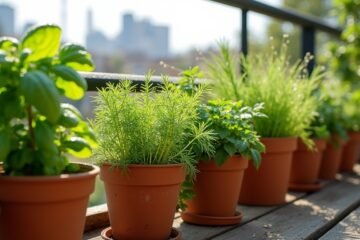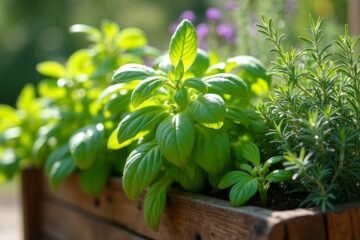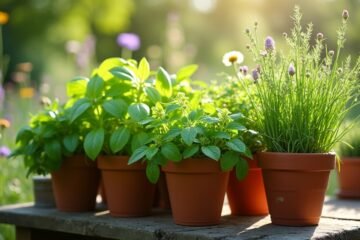Growing culinary herbs in containers at home is like inviting a culinary friend right into your kitchen! Choose cheerful pots—terracotta or colorful ceramics work wonders. Mix a light, airy soil blend with compost and perlite for happy roots. Basil and mint are perfect choices, adding fresh flavors that take your dishes up a notch! Just make sure they soak up 6-8 hours of sunlight daily. Trust me, the aroma and taste will be worth it—stick around to discover more tips!
Choosing the Right Containers for Herbs
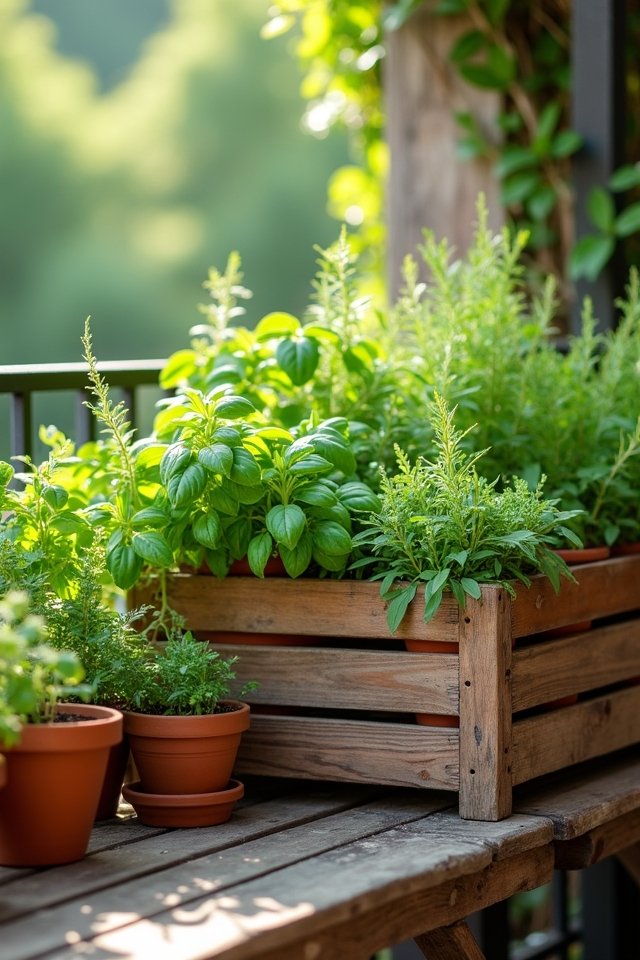
When you immerse yourself in the delightful world of container gardening, the first thing you might wonder is, “What should I use for my herbs?” Choosing the right containers isn’t just a practical decision; it’s like picking the perfect outfit for your plants! You’ve got so many options: terracotta, ceramic, and even stylish recycled plastics. Terracotta breathes beautifully, while ceramic dazzles with colors! Consider container size too—small pots may suit tiny herbs like chives, but larger containers make delightful homes for bigger plants like basil! A whimsical window box adds flair, enticing you and your neighbors! So, think about the vibe you want and what materials will make your herbs shine. Let your creativity run wild, and watch your garden bloom!
Selecting the Best Soil Mix for Container Herbs
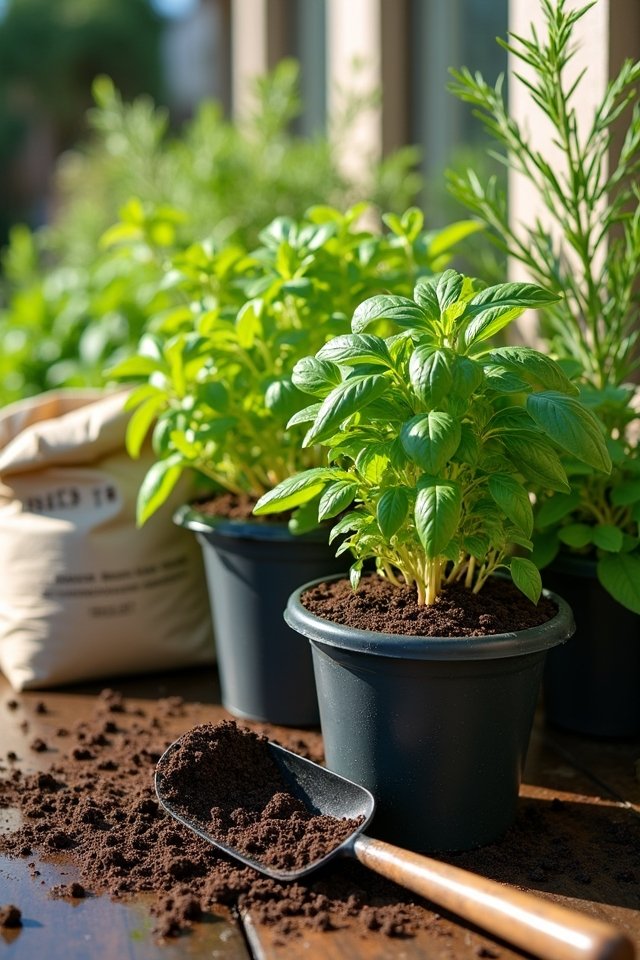
As you immerse yourself in the joys of container gardening, remember that the right soil mix is like a cozy blanket for your herbs—essential for their happiness and health! To guarantee your herbs thrive, choose a mix that promotes soil drainage and maintains a nutrient balance. After all, no one likes soggy roots!
Consider these key components for your custom blend:
- Peat moss for moisture retention
- Perlite to improve drainage
- Compost for a nutrient boost
- Coconut coir for added aeration
- Worm castings for natural fertility
Mix these together and watch your herbs flourish! You’ll not only grow a garden; you’ll cultivate an edible masterpiece that’ll have your taste buds dancing! Isn’t that deliciously exciting?
Top Culinary Herbs to Grow at Home
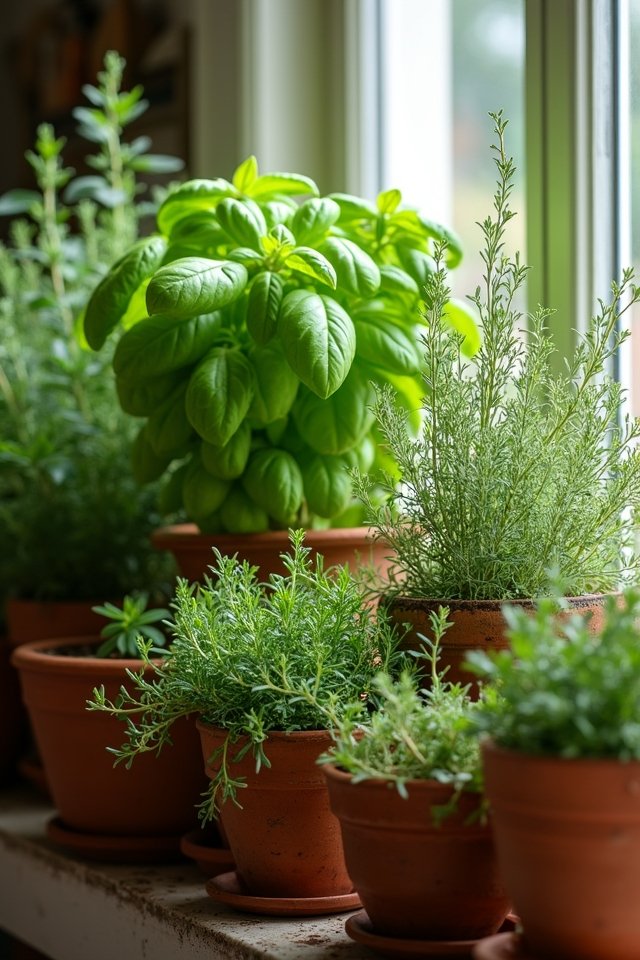
With the right soil mix cradling your herbs, it’s time to think about which culinary delights you want to grow! Basil varieties, like sweet basil and Thai basil, can elevate your pasta dishes or stir-fries to gourmet status. Imagine plucking fresh leaves for a fragrant pesto that’ll wow your friends! Then there’s mint—oh, the mint! Whether you’re leaning towards spearmint for invigorating teas or peppermint for a zing in desserts, your mint preferences can lead to delightful summer beverages. Why not plant a little of each? You’ll have a mini herb garden that’s perfect for culinary experimentation, ensuring you’re the star chef at home. Immerse yourself in this flavorful journey—it’s tastier than a walk through a farmer’s market!
Essential Sunlight Requirements for Herbs
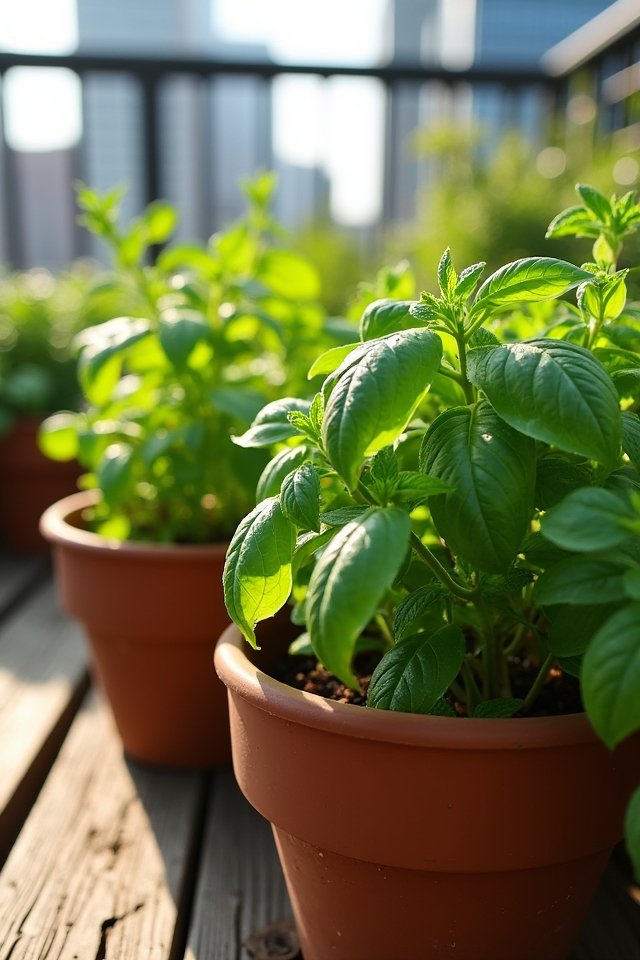
While you might dream of a lush herb garden full of vibrant greens, remember that your culinary friends thrive on sunshine! To grow your herbs successfully, pay close attention to their herb sunlight needs. They crave at least 6-8 hours of light daily. Here are some tips for maximizing light duration:
- Position your containers where they’ll soak up afternoon sun.
- Rotate pots to guarantee all sides bask in light.
- Consider using reflective surfaces to amplify sunlight.
- If indoors, place herbs near a south-facing window.
- Use grow lights if natural sunlight falls short!
With a little sunlight ingenuity, your herbs will flourish, bursting with flavor and aroma! So let the sun shine and watch those greens thrive!
Watering Techniques for Container Herbs
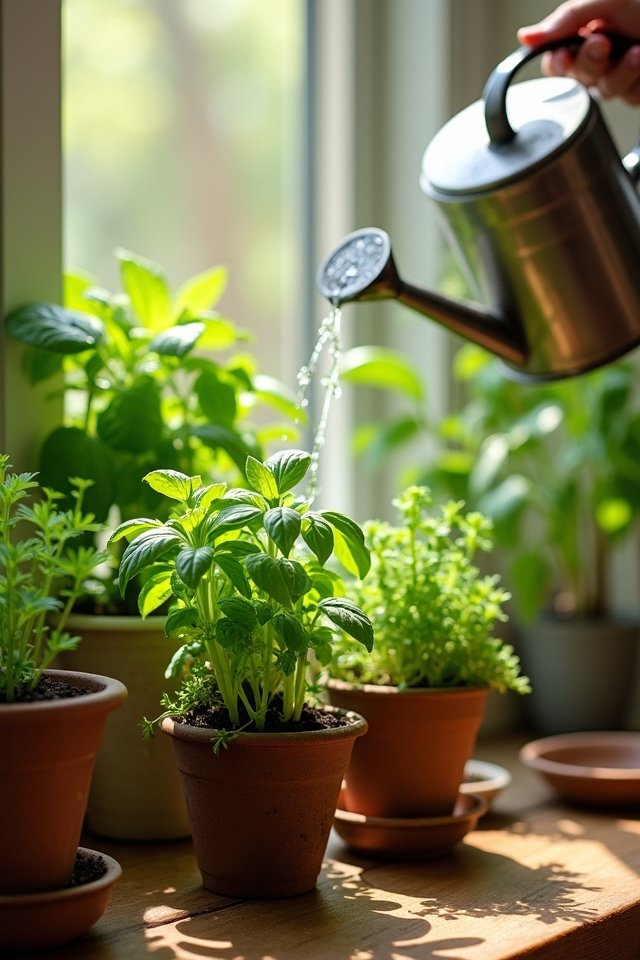
Watering your container herbs is like giving them a revitalizing drink on a hot day! To keep your plants happy, you need to master some innovative watering techniques. First, consider smart drainage solutions to prevent soggy roots. A layer of gravel at the bottom can do wonders. Next, get into the habit of moisture monitoring—use your finger to check the soil! If it feels dry down to your first knuckle, it’s watering time! Don’t just pour; get to know the plants’ thirst. Some herbs prefer a light splash, while others can handle a hearty gulp. So, wilted leaves? Not in your garden! With these tips, your culinary herbs will thrive like sun-kissed stars! Happy watering!
Fertilizing Your Culinary Herb Garden
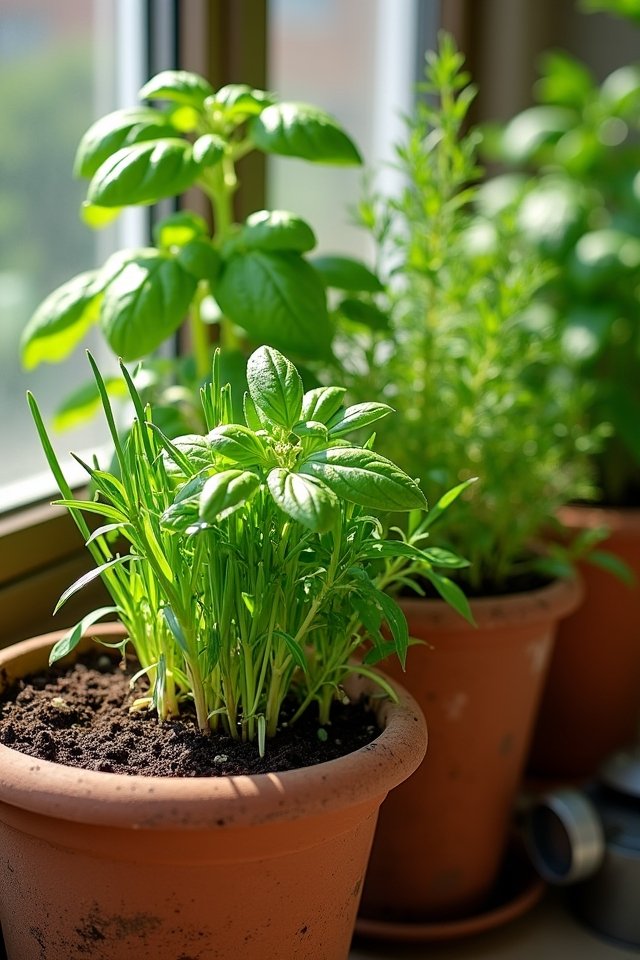
After hydrating your lovely herbs, it’s time to give them a little boost with some nourishing fertilizer! Think of it as a tasty energy drink for your plants. Using organic fertilizers is key, as they promote healthy growth without the chemical load. You can also explore liquid nutrients for a quick, effective lift.
Here are some excellent choices:
- Compost tea for a microbial boost
- Fish emulsion rich in nitrogen
- Seaweed extract to improve resilience
- Bone meal for a phosphorus kick
- Worm castings packed with goodness
Propagation Methods for Popular Herbs
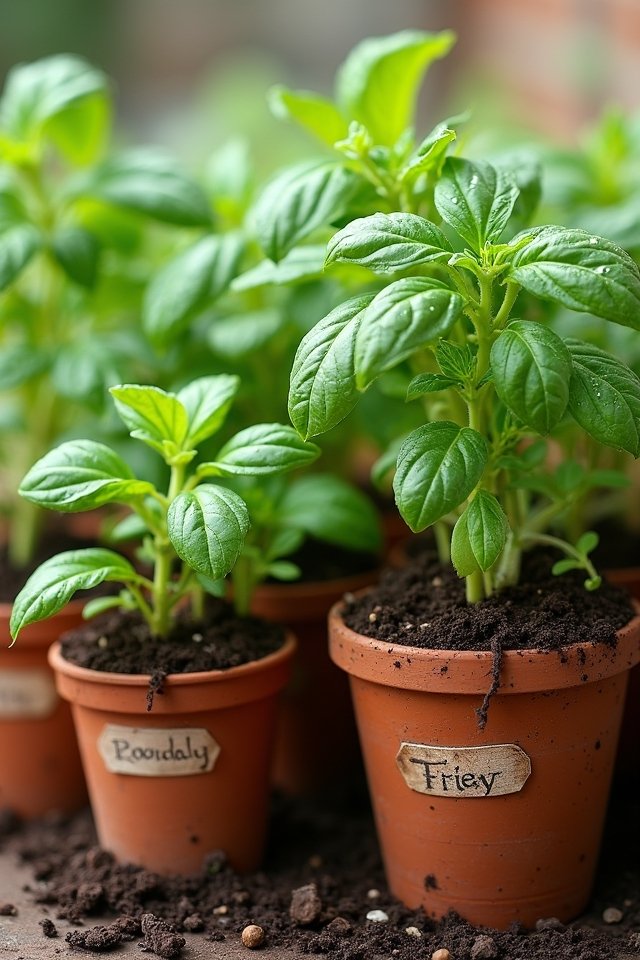
If you’re dreaming of a bountiful herb garden, you’ll be excited to learn about the fun ways to propagate your favorite culinary herbs! Think of herb cuttings as tiny culinary superheroes; just snip a stem from healthy plants like basil or mint and place it in water. In just a week or two, those roots will spring forth, ready to flourish in your container!
Or, if you’re feeling adventurous, try seed propagation! It’s like planting little treasure chests, each containing the promise of delicious flavor. Simply sow your herb seeds, water them, and watch as they sprout into vibrant plants! With these methods, your kitchen will turn into a flavor-packed oasis. Ready, set, grow your herbs!
Pest Control and Maintenance Strategies
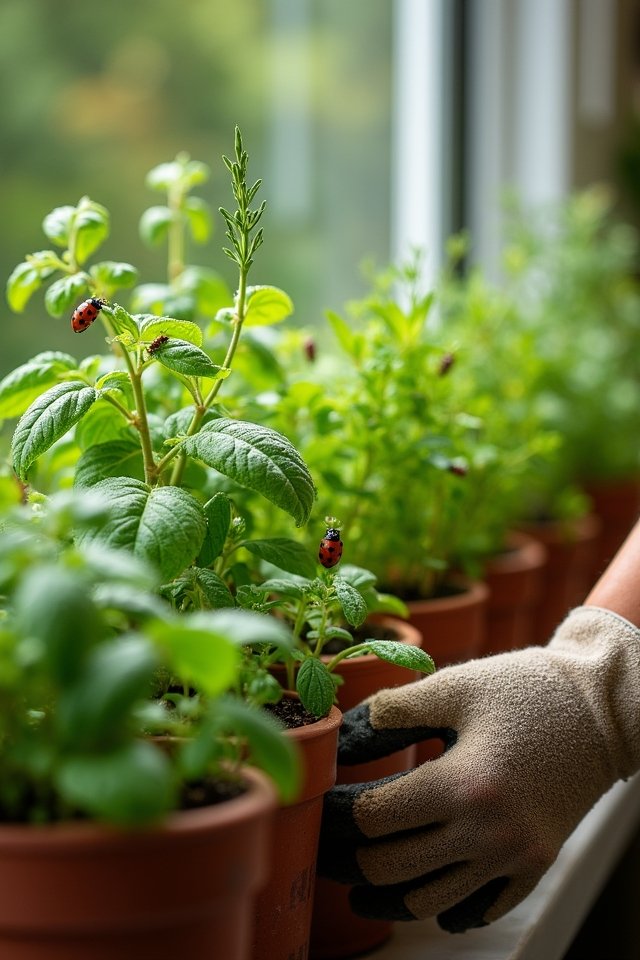
How can you keep your beloved culinary herbs thriving and pest-free? By using a combination of clever strategies that welcome nature’s allies while keeping harmful invaders at bay! Here are some fun ideas:
- Introduce natural predators like ladybugs and lacewings for an eco-friendly pest defense.
- Use organic sprays made from neem oil or insecticidal soap to deter unwanted guests.
- Rotate your herbs regularly to confuse pests and encourage growth.
- Encourage biodiversity by planting companion plants, like marigolds, to distract pesky insects.
- Inspect your herbs weekly; catching issues early is key to preserving that fragrant goodness!
With these simple, innovative techniques, you’ll savor the satisfaction of healthy herbs, minus the unwanted pests! Happy gardening!
Harvesting Techniques for Maximum Flavor
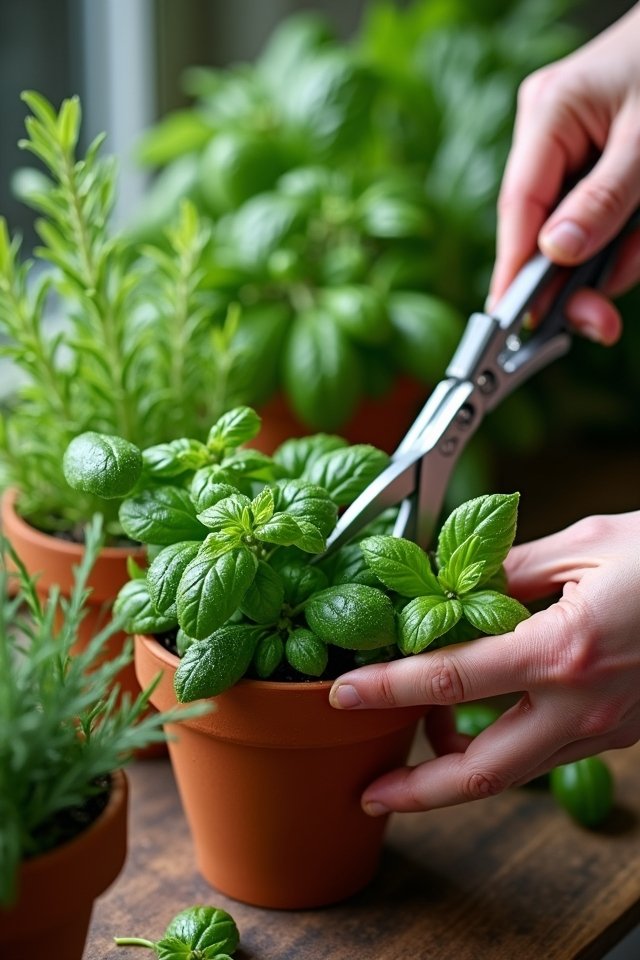
With healthy herbs in your garden, you’re just a few snips away from culinary magic! To maximize flavor enhancement, pay attention to your harvesting timing. The best time to pick is just before the herbs bloom—a sweet spot where their oils are bursting with aroma! Snip leaves early in the morning, when dew kisses the plants, ensuring peak freshness.
Try to harvest only what you need, encouraging new growth; it’s like giving your herbs a frequent spa day! For example, with basil, cutting just above a leaf node invites even fuller growth. Don’t be shy—experiment with how much you harvest. You’ll be surprised at the depth of flavor that unfolds from each colorful sprig! Happy snipping!
Seasonal Care Tips for Container Herbs
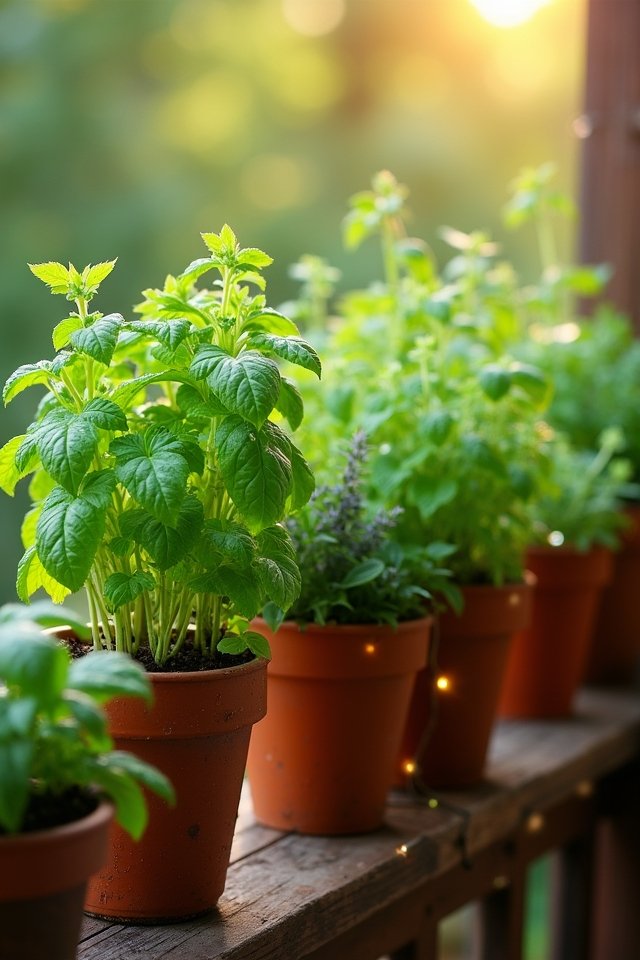
Although the seasons change, your container herbs can still thrive and delight your taste buds! Whether it’s spring planting or giving your herbs winter protection, a little seasonal care goes a long way. Here are some handy tips:
- Plant with purpose: Choose herbs that match the season’s mood.
- Water wisely: Adjust watering frequency based on temperature changes.
- Sunlight matters: Rotate your pots to catch the sun’s rays effectively.
- Fertilize regularly: Feed your herbs with organic nutrients to boost their flavor.
- Wrap it up: In winter, drape herbs with frost cloth or move them indoors for cozy warmth.
Embrace the seasonal rhythm, and watch your herbs flourish throughout the year! Who wouldn’t want fresh basil for their summer caprese salad?
Frequently Asked Questions
Can I Grow Herbs Indoors Without Natural Sunlight?
Absolutely, you can grow herbs indoors without natural sunlight! By using indoor lighting like LED grow lights, you’ll mimic Mother Nature’s nurturing glow. Hydroponic systems can also be a game-changer—just think of them as cozy little bathtubs for your herbs! It’s like giving your plants a spa day, and they’ll thrive! So, set up your own herb oasis and watch them flourish, bringing fresh aromas right to your kitchen! Exciting, right?
What Is the Best Time to Start Growing Herbs?
When it comes to growing herbs, timing is everything! The best herb varieties, like basil and chives, thrive when you plant them in the spring or early summer, taking advantage of warm sunshine. You don’t want to wait until winter’s chill sets in, or they’ll get cold feet! So, grab your pots and soil, and let those vibrant greens flourish! Seasonal planting connects you with nature, creating a joyful garden right at home!
Are There Any Herbs That Repel Pests?
You’ll love using herb pest repellents like basil and mint—they’re like tiny green bodyguards for your garden! Did you know that planting these alongside your veggies can confuse pests? It’s called companion planting, and it works wonders. Imagine a garden buzzing with happy pollinators instead of pesky bugs! So grab those herbs, and watch your plants thrive without those unwelcome munchers sneaking in for a meal. Easy peasy!
How Often Should I Rotate My Herb Containers?
Think of your herb containers as sunbathers; they crave ideal sunlight! Rotate them every week, especially if they’re indoors or in partial shade. Just like sunbathers, they need to soak up that glorious sun from all angles! This not only encourages balanced growth but also keeps pests at bay. So, keep your herbs happy and healthy by giving them a little spin—your culinary adventures will thank you for it! 🌱✨
Can I Use Kitchen Scraps to Fertilize Herbs?
Using kitchen scraps to fertilize your herbs is like giving them a gourmet meal! Think banana peels for potassium or coffee grounds for nitrogen—your plants will thrive! Herb composting tips include layering scraps in a container; it’s a recycling win! Not only do you cut waste, but you also enrich your soil naturally. Isn’t nature clever? Your herbs will thank you with vibrant leaves and delightful flavors! Isn’t that a tasty win-win?
